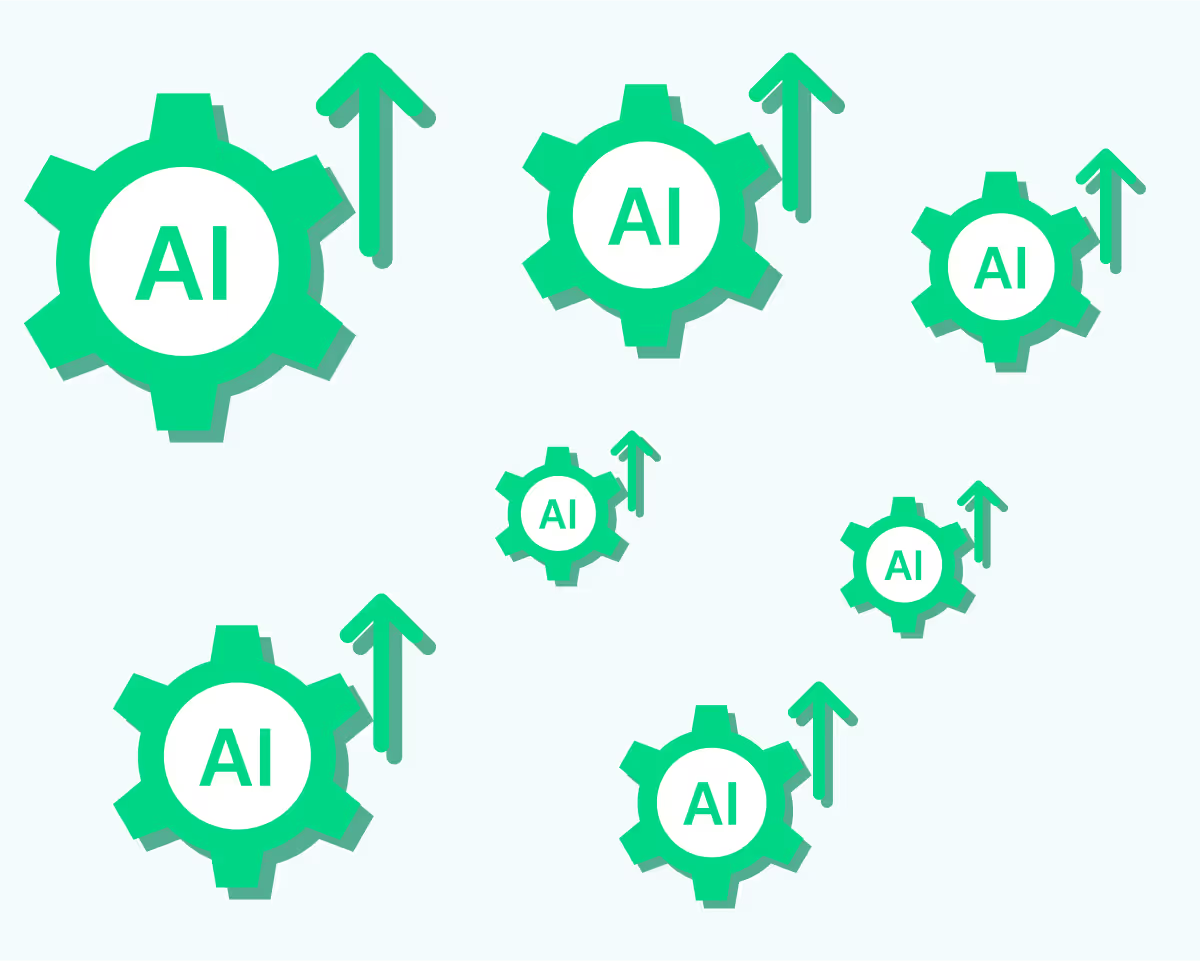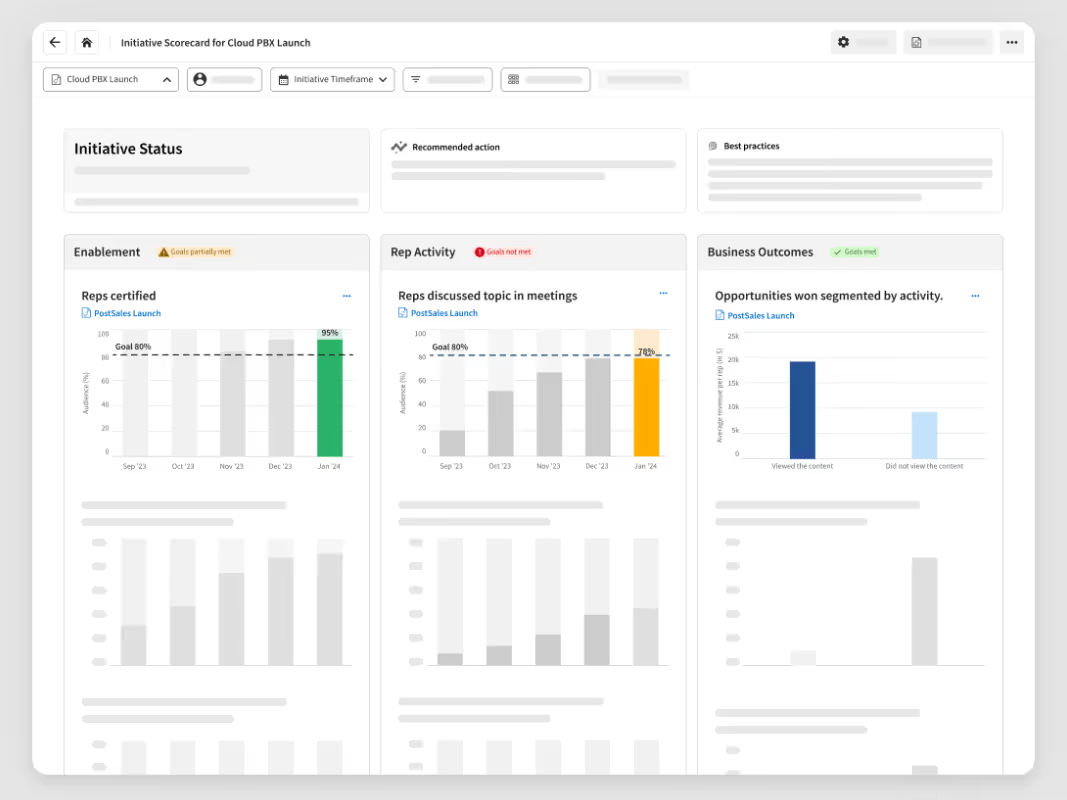Ready to create more pipeline?
Get a demo and discover why thousands of SDR and Sales teams trust LeadIQ to help them build pipeline confidently.



Sellers of all stripes are struggling to hit their numbers this year; in large part because they spend less than 30% of their workweek selling.

By investing in AI sales enablement tools, organizations can help their teams sell smarter and more effectively while reclaiming time.

No two AI sales enablement tools are the same, so it’s important to define your requirements before researching the myriad options on the market today.
Get a demo and discover why thousands of SDR and Sales teams trust LeadIQ to help them build pipeline confidently.
In 2024, a whopping 91% of sales leaders said their teams fell short of quota expectations.
This bleak reality is rooted in two distinct problems. On one hand, sales reps spend just 28% of their workweek focused on actually selling, according to Salesforce data. On the other, 71% of reps aren’t completely satisfied with the sales enablement resources they’re given, which makes it harder to do what they do best: close deals.
By investing in cutting-edge AI sales enablement tools, sales organizations can overcome these challenges — empowering their teams to unlock their full potential and crush their numbers because of it.
AI sales enablement is the process of integrating artificial intelligence into training programs, support tools, and sales workflows to equip reps with new resources and skills that make it easier to engage buyers, close deals, and consistently hit their quotas.
Traditionally, RevOps teams would invest in sales enablement tools and resources, and reps would then have to track everything they needed down themselves. By adding AI to the mix, the technology automatically surfaces the information and capabilities reps need — right when they need it. Instead of wasting time tracking down resources, AI sales enablement helps reps reclaim time they can then spend actively selling.
By the end of 2023, 50% of organizations were already using some sort of AI-powered tool for their enablement program, and 82% of that group were thrilled by the results. Judging by those results, it comes as no surprise that Gartner expects 95% of all seller research workflows will begin with AI by 2027 — up from 20% in 2024.
According to G2, 76% of sales leaders agree that better sales outcomes are a result of investments in sales enablement. By adding AI sales enablement to your processes, you’ll win more business.
There’s no shortage of AI sales enablement tools on the market today. Here’s a primer of eight popular tools to give you a better idea of what’s possible.

LeadIQ is an intelligent sales prospecting platform purpose-built to help reps sell more efficiently every day. With a roadmap full of AI-powered features, sales teams can use LeadIQ to automatically capture and enrich contact data, personalize outreach at scale, and automate repetitive prospecting workflows.
G2: 4.2 out of 5 stars (1,095 reviews)
Features:
Pricing: Free to start
Interested in taking LeadIQ for a spin? Try our free Chrome extension today.

Gong is a revenue intelligence platform that uses AI to analyze sales conversations and deal activity, helping reps optimize messaging while enabling more accurate forecasting.
G2: 4.8 out of 5 starts (6,180 reviews)
Features:
Pricing: Custom proposals based on your teams needs; per-user plus platform fee

Clari is a RevOps platform that uses AI to deliver real-time pipeline visibility while improving forecast accuracy and helping managers identify risks and opportunities in the sales cycle.
G2: 4.6 out of 5 stars (5,449 reviews)
Features:
Pricing: Not available on website

Outreach is an AI revenue workflow platform that uses AI to improve sales performance by optimizing revenue workflows and ensuring go-to-market teams stay aligned with messaging and take the right actions to engage customers successfully.
G2: 4.3 out of 5 stars (3,468 reviews)
Features:
Pricing: Not available on website

Salesloft is a sales engagement platform that uses AI to automate cadences, prioritize tasks, and provide coaching support for continuous improvement.
G2: 4.5 out of 5 stars (4,135 reviews)
Features:
Pricing: Not available on website

Highspot is a sales enablement platform that uses AI to recommend relevant sales content, track usage, and align sales conversations with buyer needs.
G2: 4.7 out of 5 stars (1,189 reviews)
Features:
Pricing: Not available on website

Salesforce Einstein is an AI layer within Salesforce that uses AI to score leads, predict deal outcomes, and suggest next-best actions to boost productivity.
G2: 4.4 out of 5 stars (23,305 reviews for Salesforce Sales Cloud)
Features:
Pricing: Starts at $2 per conversation or $500 per 100,000 credits

Seismic is a sales enablement platform that uses AI to deliver personalized content and provide insights that show how enablement efforts drive revenue.
G2: 4.7 out of 5 stars (2,312 reviews)
Features:
Pricing: Not available on website
Thinking about adding AI sales enablement tools to your tech stack? Smart move!
Unfortunately, you can’t just invest in any AI sales enablement software and expect the results you’re hoping for. To maximize the return on your investment, follow these six steps as you add AI sales enablement tools to your team’s workflows.
First things first: spend some time reviewing your existing sales workflows — from lead generation to close to post-sales activity — to find out what’s working and what could be improved.
Start by identifying how reps access resources, collaborate with their peers, and engage buyers. To do this, talk to reps and sales leaders directly to find out what the biggest challenges they face are and whether they’ve identified any inefficiencies in their workflows.
At the same time, you’ll also want to review your tech stack to see which tools reps are using and whether any are redundant or underused. You might as well use this opportunity to make sure you aren’t paying for tools you don’t need.
Make sure to capture relevant metrics like conversion rates, cycle lengths, and sales velocity to establish a baseline you can begin working to optimize once your new tools are rolled out.
Chances are you identified stages of the funnel that are slow or leaky during that first step. Scrutinize these stages further to see if you can find any manual tasks that could be automated with AI — like manual data entry or follow-ups.
While you’re at it, try to figure out where reps lose deals or are struggling to engage prospects effectively. For example, you might find out that reps are losing momentum after the initial discovery call, and that buyers go cold and don’t book demos in response to follow-ups. By analyzing CRM data and call recordings, you might realize they’re not personalizing their outreach enough.
As you identify these gaps, try to see whether you’re missing any training, sales coaching, or content resources that are leading to the issues. If there are, you’ll know what holes to plug.
Now that you’ve got a better idea of how AI sales enablement tools can help you build a stronger sales org, it’s time to drill down into the specifics: What must-have capabilities will the ideal solution have?
AI sales enablement tools come in all shapes and sizes. So, whether you’re looking for support with call coaching, content recommendations, lead scoring, or personalized outreach — or you want a tool that automatically tracks buying signals — you should be able to find a solution that meets your needs.
Enlist key stakeholders — reps, IT, sales ops, and enablement — to narrow down your options a bit. Once you’ve done that, evaluate the finalists based on reputation and use cases. Since the goal here is accelerating your sales function, choose tools that can scale; the last thing you want is to have to replace a solution as your team grows.
Now that you’ve put your shortlist together, spend time testing each tool by running pilot programs with a small group of reps. Here, you’ll want to make sure the tools you ultimately choose are not only easy to use but actually do what they’re designed to do — make life easier for reps and help them sell more.
During these trials, measure improvements in metrics like productivity, engagement, and pipeline velocity, collecting feedback from reps on what it’s like to use the tool. As your pilot programs wind down, compare notes across multiple tools and determine which tools are the winners.
You’ve made the decision and the big day’s finally arrived. Before you roll out the new tools, work with IT and sales ops to integrate them with the rest of your tech stack to ensure smooth data flow and system compatibility.
After the data is flowing between the new systems, customize workflows where you can to ensure they align with the way your team sells.
Once the system is set up, train your sales managers and reps on how to use the new tools effectively. Assuming you chose user-friendly platforms, this shouldn’t be too much of a tall order. To make life even easier for your sales team — and any new hires that’ll join at some point in the future — create onboarding resources and relevant documentation folks can refer to when they need to get up to speed or troubleshoot an issue.
At long last, the fun begins. At this point, you’re ready to start rolling out the new AI sales enablement tools to the entire team. But you’ll still want to be a little patient. Deploy the software in phases, starting with high-impact teams or regions. That way, if there are any hiccups, you can remedy them right away.
As the tools roll out, monitor adoption and any challenges users face. If possible, identify some success stories and early wins to build buy-in across your org. As you scale, continue to refine your sales training and onboarding programs as you identify gaps and pain points.
Once your team is equipped with the new tools, start measuring the impact of the technology by tracking metrics like content usage rates, time spent selling, win rates, and average deal size. If you find out that your salespeople are spending several more hours each week selling, you’ll know that your investment was a winner.
Picking the right AI sales enablement tools starts with clearly understanding your team’s challenges, goals, and workflows and choosing solutions that help them achieve better sales outcomes. With so many different options on the market today, it’s important to consider each of these elements before making a decision.
The ideal AI sales enablement tools will naturally be packed full of features that make selling easier. Depending on your priorities, you might want tools that help automate repetitive workflows or can help with email personalization. You might also be interested in tools that offer real-time coaching capabilities or automated lead scoring. Whatever the case may be, a tool won’t do you any good if it doesn’t have the features you need.
The whole point of AI sales enablement tools is to help reps work more effectively. That being the case, it’s critical that the tools integrate with your existing tech stack — including your CRM (e.g., Salesforce or HubSpot) and any other sales tools you rely on (e.g., Gong, Salesloft, and Outreach). Look for solutions that offer robust two-way integrations and require minimal IT resources to implement and manage.
In today’s increasingly privacy-conscious world, it’s important to look for tools that comply with industry standards (e.g., SOC 2) and are purpose-built to keep data private and secure. Ultimately, AI is only as strong as the data that’s powering it — and that starts with strong data protection capabilities.
Do the tools you’re considering fit within your budget? Be sure to understand the pricing model of the tools in question. Do they charge per user? Per feature? Per usage? Evaluate these costs compared to the potential ROI you expect to achieve via the investment.
The AI sales enablement tools you choose should be able to keep pace with business — which is why it’s critical to consider scalability before signing a contract. Ask would-be vendors about user caps, enterprise support, and service-level agreements (SLAs) to see whether the tool can grow alongside your team. Remember, choosing a scalable platform today prevents major headaches in the future.
The best AI sales enablement tools help companies increase rep productivity, improve win rates, and make revenue more predictable by automating recurring workflows, personalizing outreach at scale, and ensuring reps have instant access to the actionable insights they need to sell smarter.
LeadIQ does this by automatically updating and enriching CRM data, using generative AI to personalize messages in just a few clicks, and helping reps rapidly identify top prospects via contact tracking and champion tracking capabilities.
To see why top-performing sales teams use LeadIQ to prospect every day, try our Chrome extension for free right now. Curious to learn more about LeadIQ? Schedule a live demo today.